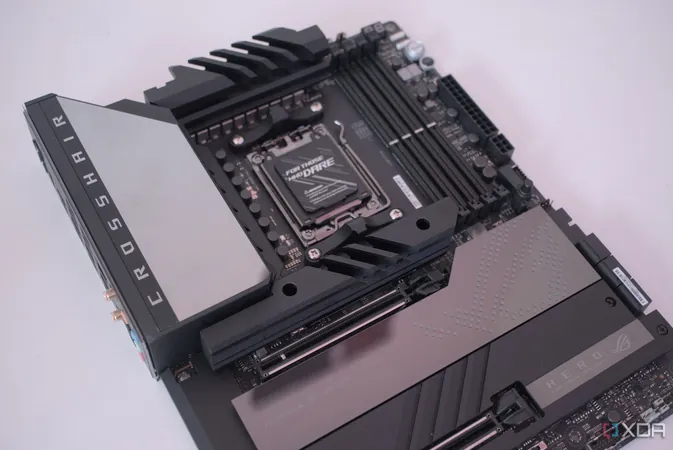
7 PC Hardware Specs Gamers Simply Don't Care About! Find Out What They Are!
2025-03-30
Author: Jacob
When diving into the deep end of PC gaming, it's easy to become overwhelmed by a plethora of specifications for each component. The myriad of motherboards, graphics cards, and storage solutions can leave even the most dedicated gamers feeling paralyzed by choice. Most gamers focus on a select few specifications, while numerous other details fade into the background. Here are seven specifications that the average gamer often overlooks, but they could be important for the more seasoned enthusiast!
1. Fan Speed and Pressure on AIO Coolers: The Silent Overkill!
If you're considering an All-in-One (AIO) liquid cooler for your rig, you're likely thinking about its cooling performance and aesthetics. However, details such as fan RPM and static pressure often take a backseat. While these specs are essential in high-performance setups or for those looking to squeeze every bit of cooling potential, the average gamer typically prioritizes attributes like design, cooling efficiency, and compatibility. Most gamers know that even budget air coolers are capable of keeping CPUs within safe temperate levels during regular gaming, so they need not fret about every detail!
2. PCIe 5.0 and ATX 3.0 Power Supplies: Nice to Have, but Not Essential!
As recent years have ushered in powerful GPUs like Nvidia's RTX 40 and RTX 50 series, ATX 3.0 power supplies and PCIe 5.0 connectors have garnered attention. Nevertheless, the practical implications of these specs are often lost on gamers. Many still opt for older, budget-friendly power supplies without the latest specs, comfortably using adapters to connect to newer graphics cards. For most gamers, performance and price are the primary factors, making these advanced specs seem unnecessary.
3. VRM Phases on Motherboards: Extra Phases but Not a Deal-Breaker!
A motherboard's power delivery system, which includes the number of VRM (Voltage Regulator Module) phases, often becomes a marketing gimmick. While it might boast 12, 14, or even 16 phases, the average gamer cares far more about essential features such as the number of RAM slots and USB connectivity. Once gamers find a motherboard that meets their main criteria—design, compatibility, and price—additional VRM phases stay at the bottom of their radar.
4. DRAM Cache on SSDs: The Hidden Performance Boost!
Some SSDs come with DRAM (Dynamic Random-Access Memory) chips that act as caches, enhancing performance during tasks like video editing. However, many gamers remain unaware of this tech during their purchasing decisions. They focus more on read and write speeds along with cost, opting for DRAM-less SSDs when they see significant savings. Although DRAM can boost performance, especially in write-heavy tasks, most gamers still find they’ve got plenty of speed even without it.
5. CAS Latency on RAM: The Overlooked Speed Factor!
CAS latency, a crucial aspect of RAM specs, often gets swept under the rug, especially with the newer, faster DDR5 RAM. Gamers are more likely to focus on the overall speed rather than the finer details of latency. For example, most don’t differentiate between a DDR5-6000 CL30 and a DDR5-6000 CL36 kit; they’ll simply choose based on price. This means that in the race to get the latest power, latency often becomes an afterthought.
6. Unlocked Multiplier on CPUs: The Obsolescence of Overclocking!
With most modern CPUs, particularly those from AMD and Intel, featuring unlocked multipliers for overclocking, you'd think eager gamers would take advantage. However, the popularity of overclocking has waned as chips are now tuned close to their limits. The average enthusiast typically isn't interested in fine-tuning settings for marginal gains; they prefer a straightforward, powerful CPU that performs well out of the box. In a world dominated by GPU performance, the intricate details of CPUs often take a backseat.
7. AI TOPS on GPUs: The Metrics that Miss the Mark!
Nvidia’s recent emphasis on AI performance with the RTX 50 series dazzled audiences but left gamers cold. Specifications like TOPS (trillions of operations per second) for AI tasks have little sway when most gamers are focused on immediate performance benefits. The latest discussions post-launch revolve around practical features and pricing rather than deep dives into complex AI metrics.
Final Thoughts: Focus on What Matters!
While many of the specifications listed may seem critical to the untrained eye, most gamers care mainly about brand recognition, price, and core performance. The lesser-known specs rarely factor into actual purchase decisions. This phenomenon illustrates a gap between manufacturer marketing and gamer interest, prompting companies to rethink what details they emphasize. So, if you're a gamer, focus on the features that truly resonate with your gameplay experience and don’t get bogged down in the minutiae!









 Brasil (PT)
Brasil (PT)
 Canada (EN)
Canada (EN)
 Chile (ES)
Chile (ES)
 Česko (CS)
Česko (CS)
 대한민국 (KO)
대한민국 (KO)
 España (ES)
España (ES)
 France (FR)
France (FR)
 Hong Kong (EN)
Hong Kong (EN)
 Italia (IT)
Italia (IT)
 日本 (JA)
日本 (JA)
 Magyarország (HU)
Magyarország (HU)
 Norge (NO)
Norge (NO)
 Polska (PL)
Polska (PL)
 Schweiz (DE)
Schweiz (DE)
 Singapore (EN)
Singapore (EN)
 Sverige (SV)
Sverige (SV)
 Suomi (FI)
Suomi (FI)
 Türkiye (TR)
Türkiye (TR)
 الإمارات العربية المتحدة (AR)
الإمارات العربية المتحدة (AR)